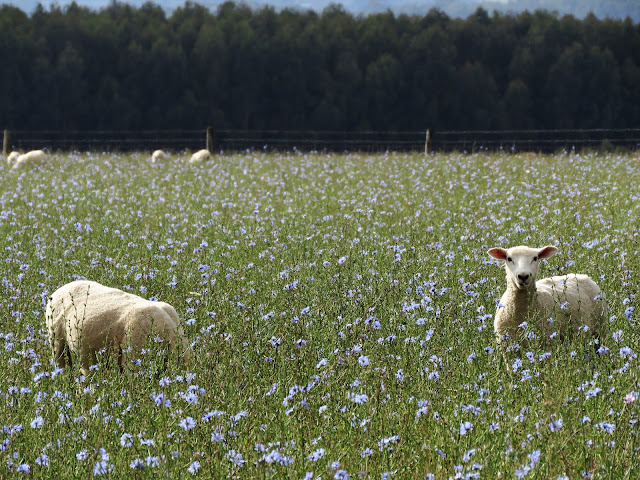Cruising past a paddock on the way from Birregurra to Apollo Bay, back in February this year, I saw a field of pale blue, with sheep. I took a few pictures, which I'll share with you, but no close-ups of the flowers.
I wasn't sure if it was a crop or a crop weed, but it looked a bit like Common Flax, also known as Linseed, or botanically, Linum usitatissimum*.
There are about 230 species of Linum, all given the common name flax, and not to be confused the New Zealand Flax, Phormium tenax. One species, Linum marginale, is common and widespread in Victoria and all other states and territories except Northern Territory, plus New Zealand, and a few exotic species are grown here in cultivation.
Linum sits with a dozen of so fairly obscure genera in a family call Linaceae, It's a family that hasn't change much in its circumscription with the advent of molecular (DNA) sequencing.
Linum itself includes mostly small plants with typically 5-petalled flowers.
Common Flax has been cultivated by humans
for some 10,000 years and what we call
Linum usitatissimum is a self-pollinating plant, bred in Europe or the Middle East from
Linum angustifolium, as oil plant.
The Common Flax is also a weed of the basalt plains west of Melbourne - where this crop was situated.
When grown deliberately, as it seems to be here, it is either for fibre to weave into linen (or traditionally to make paper, rope and many other products) or for its seed to extract linseed or flax oil. Whole flax seeds have also had a revival in recent years as a source of fibre and antioxidants, in similar fashion to the seed of an unrelated Salvia species, called chia.
Assuming this is a deliberate crop, I'm sure it would be for seed and oil. I gather varieties grown for fibre are taller and, in any case, I'm not aware of flax being grown commercially (at least in recent times) for linen production in Victoria.
I do know, or at least have
read, that the native species -
Linum marginale - is used by First Nations people to make rope for fish nets, and the seeds eaten raw or cooked.
The sheep in my picture seem to enjoy grazing on the flax, or at least what's between it. While there are reports of the native species being potentially toxic to livestock, there is no suggestion of that for the Common Flax.
As I said, I didn't get close enough to photograph the flowers in any details so instead you can enjoy this floral dissection by Walther Otto Müller, from Köhler's Medizinal-Pflanzen (available through
WikiMedia Commons).
*My botanically wiser colleague, Neville Walsh, thinks it may well be Chicory, Cichorium intybus, which has similar-coloured, but daisy-shaped, flowers. Looking again at the pictures I suspect he is right: Chicory is a common weed of disturbed areas in Victoria. But because that diagnosis came after I posted this missive, I'll stick with my story about flax. Chicory can wait for another day!





Comments